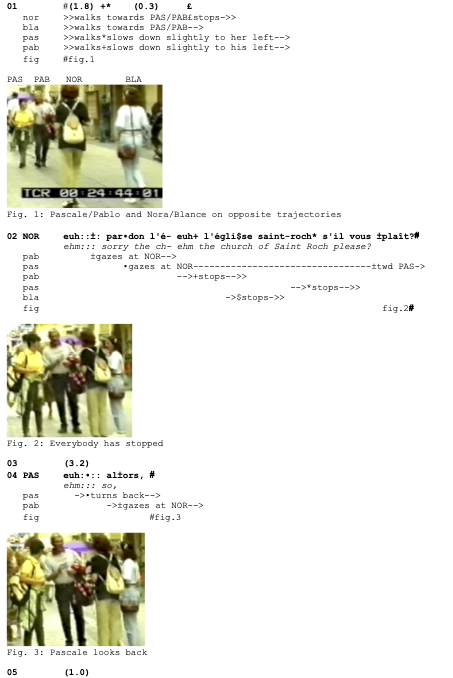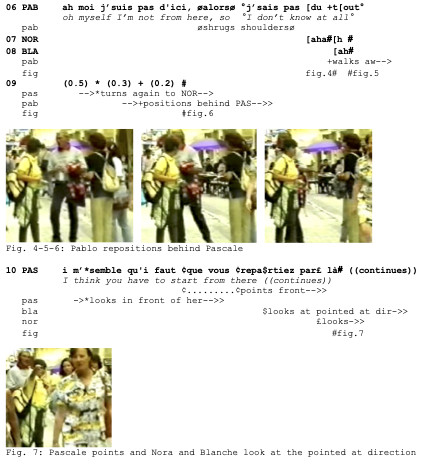Difference between revisions of "Interactional space"
ChaseRaymond (talk | contribs) |
ChaseRaymond (talk | contribs) |
||
| Line 24: | Line 24: | ||
<u>(1) [STR/MPT_E9_iti9] (Mondada, 2009; De Stefani & Mondada, 2018)</u> | <u>(1) [STR/MPT_E9_iti9] (Mondada, 2009; De Stefani & Mondada, 2018)</u> | ||
| − | |||
| − | [[File:Mondada-space-2rev.png| | + | [[File:Mondada-space-1.png|650px]] |
| + | |||
| + | [[File:Mondada-space-2rev.png|650px]] | ||
The two couples walk from opposite directions towards each other (Figure 1). Blanche and Nora initiate the focused interaction by converging on Pascale and Pablo, who respond by slowing down their walk and modifying their trajectory. While the former project an encounter, the latter project avoiding a collision. As Nora produces her emergent request (line 1), Pablo and Pascale respond by looking at her (line 2), still stepping forward, and then, when the name of the targeted landmark is produced, definitively stopping. The interactional space for the focused encounter is thus established when everybody has stopped and stabilized their now immobile bodies, tacitly aligning as participants to a face-to-face interaction (Figure 2). | The two couples walk from opposite directions towards each other (Figure 1). Blanche and Nora initiate the focused interaction by converging on Pascale and Pablo, who respond by slowing down their walk and modifying their trajectory. While the former project an encounter, the latter project avoiding a collision. As Nora produces her emergent request (line 1), Pablo and Pascale respond by looking at her (line 2), still stepping forward, and then, when the name of the targeted landmark is produced, definitively stopping. The interactional space for the focused encounter is thus established when everybody has stopped and stabilized their now immobile bodies, tacitly aligning as participants to a face-to-face interaction (Figure 2). | ||
Revision as of 23:16, 2 January 2024
| Encyclopedia of Terminology for CA and IL: Interactional space | |
|---|---|
| Author(s): | Lorenza Mondada (University of Basel, Switzerland) (https://orcid.org/0000-0002-7543-9769) |
| To cite: | Mondada, Lorenza. (2023). Interactional space. In Alexandra Gubina, Elliott M. Hoey & Chase Wesley Raymond (Eds.), Encyclopedia of Terminology for Conversation Analysis and Interactional Linguistics. International Society for Conversation Analysis (ISCA). DOI: [] |
Interactional space refers to the dynamic (re)arrangement of participants’ bodies in the environment, as interaction unfolds. It is continuously achieved through the finely-tuned coordination, mutual adjustment, and collective distribution of bodies in space while participants interact together.
The relevance of space for embodied interactions has been pinpointed by several authors. It was recognized early on in the interactionist tradition: Goffman (1961, 1963, 1971) showed that body arrangements in space create temporary and changing, bounded territories, and delimit a temporary ‘ecological huddle’ (1964), recognized by participants involved in the encounter as well as by bystanders. This interest in temporary territories drawn by bodies in action was shared by Ashcraft and Scheflen (1976). Working with Scheflen, Kendon (1990: 248-249) conceptualized this territory by introducing the notion of “F-formation”: body positions and orientations that build an arrangement favoring a common focus of attention and engagement in a joint activity, which is also crucial for an interpretation of what is going on (1990: 251). F-formations can be studied by emphasizing their lability or their stability: whereas Kendon points out that F-formations, once established, have a durable nature, it is also possible to highlight their dynamic and ever-changing nature.
Building on this tradition, Goodwin (2000, 2002, 2003, 2007) introduced the notion of “contextual configurations”: the space drawn by the mutual relationships between embodied actions and the material environment. Contextual configurations frame and make visible unfolding action as it is organized by a multiplicity of semiotic resources (2000: 1490). For instance, the arrangement of multiple bodies can provide for the contextualization of gesture (2002).
Drawing from these inspirations, Mondada (2005, 2009, 2011) proposed that the participants’ “interactional space” is constituted through the situated, mutually adjusted changing arrangements of their bodies within space, as they are made relevant by and for their current activity, their mutual attention and common focus of attention, and the way in which they coordinate in joint action. The interactional space is continuously (re-)established, achieved, and transformed within the activity (De Stefani & Mondada, 2018; LeBaron & Streeck, 1997; Mondada, 2009, 2011).
Defined in this way, the notion of interactional space contributes both to an interactional conceptualization of space and to a spatial conceptualization of interaction.
As regards the former, it implies a praxeological perspective on space, insisting on the reflexive elaboration of situated action and relevant spatial features. Material surroundings of action are both constraints and resources—space being action-shaping and action-shaped, conceived in a way that avoids any spatial determinism. Dynamically unfolding moment by moment within the coordinated adjustment of several actions and sets of multimodal resources, the interactional space is finely related to the sequential and temporal organization of talk and embodied action.
As regards the latter aspect, the notion of interactional space attends to the context of the interaction by considering the material and spatial environment of talk; it enlarges the conceptualization of multimodality by taking into consideration the movements of the entire body; and it integrates mobility as a relevant organizational feature of social interaction (Haddington, Mondada, & Nevile, 2013). Likewise, the focus on interactional space attends to the spatial dimension of participation framework and crucially its embodied nature (see Goodwin, 2000; Goodwin & Goodwin, 2004 on embodied participation).
The establishment and transformation of the interactional space are shown below. Two persons walking on a public street (Nora and Blanche) ask a couple of passers-by (Pascale and Pablo) for directions. Several transformations of the interactional space are observable:
- its establishment in the openings (lines 1-2; D’Antoni, et al., 2022; De Stefani & Mondada, 2018; Pillet-Shore, 2018);
- its first transformation from a face-to-face formation between two couples to one with three persons (lines 3-9);
- and then another transformation into a spatial arrangement engaging in the route description and instruction (lines 10ff).
(1) [STR/MPT_E9_iti9] (Mondada, 2009; De Stefani & Mondada, 2018)
The two couples walk from opposite directions towards each other (Figure 1). Blanche and Nora initiate the focused interaction by converging on Pascale and Pablo, who respond by slowing down their walk and modifying their trajectory. While the former project an encounter, the latter project avoiding a collision. As Nora produces her emergent request (line 1), Pablo and Pascale respond by looking at her (line 2), still stepping forward, and then, when the name of the targeted landmark is produced, definitively stopping. The interactional space for the focused encounter is thus established when everybody has stopped and stabilized their now immobile bodies, tacitly aligning as participants to a face-to-face interaction (Figure 2).
After a lapse (line 3), Pascale begins to answer Nora’s request (line 4), displaying her willingness to provide a route description. To give appropriate directions she turns towards possibly relevant directions within the local environment (Figure 3). The interactional space is thus dynamically modified to integrate the landmark and the participants’ orientation towards it.
However, before Pascale projected description is actually produced, Pablo announces (line 6) his inability to respond, claiming membership in the category “stranger”, which makes him unavailable for the task at hand. This announcement is responded to by a change-of-state token by the recipients, Nora and Blanche, while Pablo embodies his unavailability by moving behind Pascale (Figures 4-6). In this way, he changes the interactional space, literally exiting from the face-to-face formation of all four participants, therefore changing the participation framework by letting Pascale interact with Nora and Blanche.
As Pablo is stepping behind her, Pascale turns her head again towards Nora and Blanche, and begins to deliver the route description and to point to the landmark, now engaging in the spatial instructions (line 10). Her recipients turn their gaze and body in the pointed at direction. These collective movements towards the landmark and within the action of instructing the way further transform the interactional space, adjusting it to the ongoing activity of the itinerary description.
This fragment shows the dynamic character of the interactional space, constituted through the changing assembling of the participants, adjusting to the moment-by-moment multimodal production of their actions. Inclusions and exclusions, modifications of the participation framework, recipient design and mutual orientations are made visible by the bodily positions of the participants, shaping the evolving interactional space.
Additional Related Entries:
Cited References:
Ashcraft, N., & Scheflen, A. E. (1976). People space: The making and breaking of human boundaries. Anchor.
D’Antoni, F., Debois, T., De Stefani, E., Hänggi, P., Mondada, L., Schneerson, J. & Burak S.T. (2022). Encounters in public places: The establishment of interactional space in face-to-face openings. In A. H. Jucker & H. Hausendorf (eds.), Pragmatics of space (pp. 281-315). De Gruyter.
De Stefani, E., & Mondada, L. (2018). Encounters in public space: How acquainted versus unacquainted persons establish social and spatial arrangements. Research on Language and Social Interaction, 51(3), 248-270.
Goffman, E. (1961). Asylums. Anchor.
Goffman, E. (1963). Behavior in public places: Notes on the social organization of gatherings. Free Press.
Goffman, E. (1964). The neglected situation. American Anthropologist, 66(6), 133-136.
Goffman, E. (1971). Relations in public: Microstudies of the public order. Harper and Row.
Goodwin, C. (2000). Action and embodiment within situated human interaction. ournal of Pragmatics, 32(10), 1489-1522.
Goodwin, C. (2002). Time in Action. Current Anthropology, 43(S4), 19-35.
Goodwin, C. (2003). The body in action. In J. Coupland & R. Gwyn (eds.) Discourse, the body and identity (pp. 19-42). Palgrave/Macmillan.
Goodwin, C. (2007). Environmentally coupled gestures. In S.D. Duncan, J. Cassell, & E.T. Levy (eds.) Gesture and the dynamic dimension of language (pp. 195-212). John Benjamins.
Goodwin, C., & Goodwin, M. H. (2004). Participation. In A. Duranti (ed.) A companion to linguistic anthropology (pp. 222-244). Blackwell.
Haddington, P., Mondada, L. & Nevile, M. (eds.) (2013). Mobility and interaction. De Gruyter.
Kendon, A. (1990). Conducting interaction: Patterns of behavior in focused encounters. Cambridge University Press.
LeBaron, C. D., & Streeck, J. (1997). Built space and the interactional framing of experience during a murder interrogation. Human Studies, 20, 1-25.
Mondada, L. (2005). La constitution de l’origo déictique comme travail interactionnel des participants: une approche praxéologique de la spatialité [The constitution of deictic origo as an interactional achievement of participants: a praxeological approach of spatiality]. Intellectica, 41-42(2/3), 75-100.
Mondada, L. (2009). Emergent focused interactions in public places: a systematic analysis of the multimodal achievement of a common interactional space. Journal of Pragmatics, 41, 1977-1997.
Mondada, L. (2011). The interactional production of multiple spatialities within a participatory democracy meeting. Social Semiotics, 21(2), 283-308.
Pillet-Shore, D. (2018). How to begin. Research on Language and Social Interaction, 51(3), 213-231.
Additional References:
Duranti, A. (1992). Language and bodies in social space: Samoan ceremonial greetings. American Anthropologist, 94(3), 657-691.
Erickson, F. (1975). One function of proxemic shifts in face-to-face interaction. In A. Kendon, R. M. Harris, & M. R. Key (eds.), Organization of behavior in face-to-face interaction (pp. 175-188). De Gruyter.

